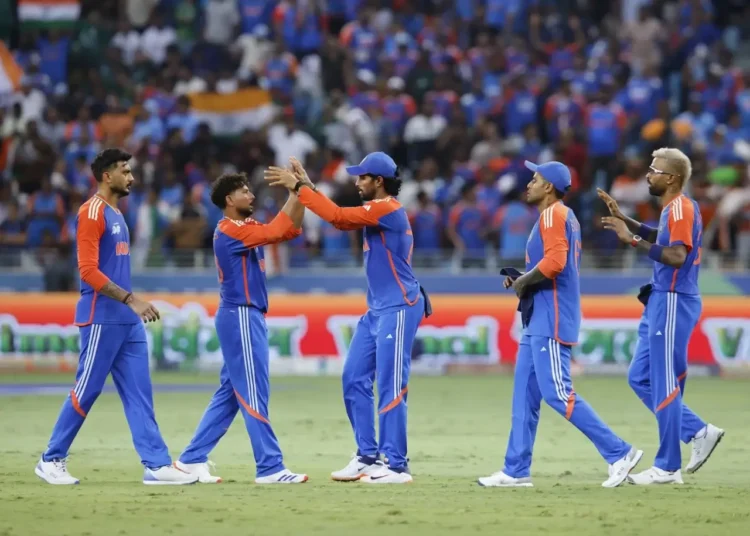India’s seven-wicket win over Pakistan in Dubai will be remembered for more than just the no-handshake episode. Beyond the political tension, the defining narrative was India’s tactical use of spin. The middle overs became a story of suffocation, where Axar Patel and Kuldeep Yadav combined to squeeze the life out of Pakistan’s batting.
At 42 for 2 after the powerplay, Pakistan were still in the game. But instead of building steady partnerships, they slipped into a defensive shell. India’s spinners kept attacking fields in place, drying up singles and forcing risky strokes. The result was a collapse that revealed both India’s discipline and Pakistan’s impatience.
This was not simply a contest of skill. It was a reflection of how well-prepared India was for conditions and how unsettled Pakistan became once pressure mounted. The tactics of not including Arshdeep worked, even after he had a successful campaign for the Punjab Kings. The gulf was not in talent, but in composure, clarity, and execution under pressure.
India’s Middle Overs Masterplan
The turning point came when Axar Patel began his spell with precision. His dismissal of Fakhar Zaman, deceived in flight, and Salman Agha, undone by desperation, shifted momentum decisively. Pakistan’s scoring options shrank, their strike rotation vanished, and the innings stalled at a dangerous time.
Kuldeep Yadav followed soon after, striking twice in the thirteenth over with his variation and flight. His loopy legbreak and a sharp wrong’un exposed Pakistan’s uncertainty against wrist spin. Suryakumar Yadav’s field placements added to the pressure, with close-in catchers creating a sense of entrapment.
From over six to fifteen, Pakistan barely found boundaries. Dot balls piled up, mistakes multiplied, and the batting order unraveled. By the halfway stage, Pakistan was tottering with no way back. India’s spinners had turned the match into a tactical chokehold.
The difference was not only in execution but in mindset. India’s bowlers trusted their plans and waited patiently for mistakes. Pakistan’s batters, instead of absorbing pressure, tried to break free with rash strokes. Their inability to rotate the strike turned composure into panic, and panic into collapse.
Why Was Three Spinners a Masterstroke?
Leaving Arshdeep Singh out raised eyebrows before the toss. Yet the decision to play three spinners was a tactical stroke of genius. Dubai’s surface was dry and slow, offering grip that spinners could exploit. By rotating Kuldeep, Axar, and Abhishek, India ensured there was no escape route for Pakistan’s batters.
The strategy gave Suryakumar Yadav freedom to maintain attacking fields for longer spells. With spin at both ends, batters had no opportunity to settle. The trio offered variation too — Axar’s accuracy, Kuldeep’s deception, and Abhishek’s control — making Pakistan second-guess every ball.
This move also showed India’s ability to adapt to conditions to its advantage. Rather than relying on pace depth, they trusted spin to dictate tempo. In doing so, they not only picked wickets but drained Pakistan’s confidence and scoring rhythm.
Reading the Conditions Better
India’s management judged the pitch and dew factor perfectly. They anticipated that spinners would play a bigger role before the dew set in. By front-loading spin pressure, they exploited conditions while Pakistan’s strategy remained conventional. This difference in planning widened into a gulf during the middle overs.
Skill Gap or Mindset Gap Between Rivals?

On paper, both teams carry talent. Pakistan has young flair players, and India has depth across formats. But what separated them in Dubai was not raw skill; it was mental resilience. India’s spinners bowled with clarity, while Pakistan’s batters looked overwhelmed by pressure.
Even Pakistan’s coach Mike Hesson admitted that his side grew frantic after the powerplay. Their inability to rotate strike or build calm partnerships exposed a deeper issue. Talent without composure becomes fragile when the opposition builds sustained pressure.
India’s system, shaped by role clarity and experience, thrives in high-pressure games. Pakistan, meanwhile, continues to search for stability in both selection and execution. The gap, therefore, lies less in ability and more in mental strength.
Lessons Pakistan Must Take Away
Pakistan must treat such matches as learning platforms rather than meltdowns. Strike rotation and calm partnerships are just as vital as boundary hitting. If they can develop trust in their process and shield players from panic, the gap with India can narrow quickly. But without that change, the script may keep repeating.
Pakistan’s Focus Away From Cricket
The political noise surrounding the match was impossible to ignore. The no-handshake controversy and post-match protests dominated headlines as much as the cricket itself. Such distractions seep into preparation, leaving players unsettled before they even step onto the field.
India, on the other hand, blocked out external noise and played with clarity. Pakistan seemed burdened by off-field issues, which showed in their hesitant batting. Leadership instability, frequent selection debates, and public criticism add further pressure on a young squad still trying to find its identity.
The upcoming match against the UAE is now crucial. To progress to the Super Four, Pakistan must put aside distractions and play with focus. If they continue to allow off-field matters to cloud cricket, results will follow the same disappointing pattern.
Resetting Priorities
For Pakistan, simplifying strategy, backing chosen players, and blocking unnecessary noise are urgent needs. Until cricket becomes the only focus, consistency will remain elusive. Their young talent deserves better clarity and calmer conditions to flourish.
Conclusion
India’s win was not about flashy moments but smart execution. The decision to play three spinners turned Dubai’s surface into a weapon. Axar Patel and Kuldeep Yadav then used that platform to strangle Pakistan’s batting into submission.
This match exposed a contrast: India’s clarity versus Pakistan’s confusion. Where one side trusted plans, the other fell into panic. Where India adapted to conditions, Pakistan stuck with convention. In the end, the difference was mental strength and tactical awareness.
Pakistan still have a chance to redeem themselves in the Super Four. But they must strip away distractions, focus on cricket, and rebuild confidence in their batting. If not, India will continue to dominate these high-pressure encounters, and the gap will only widen further.






